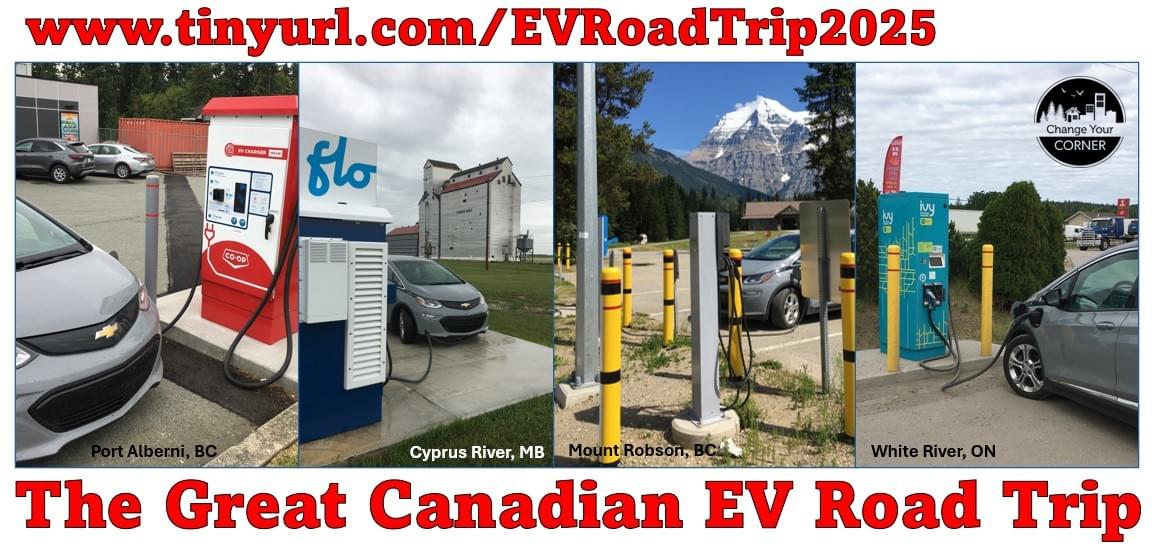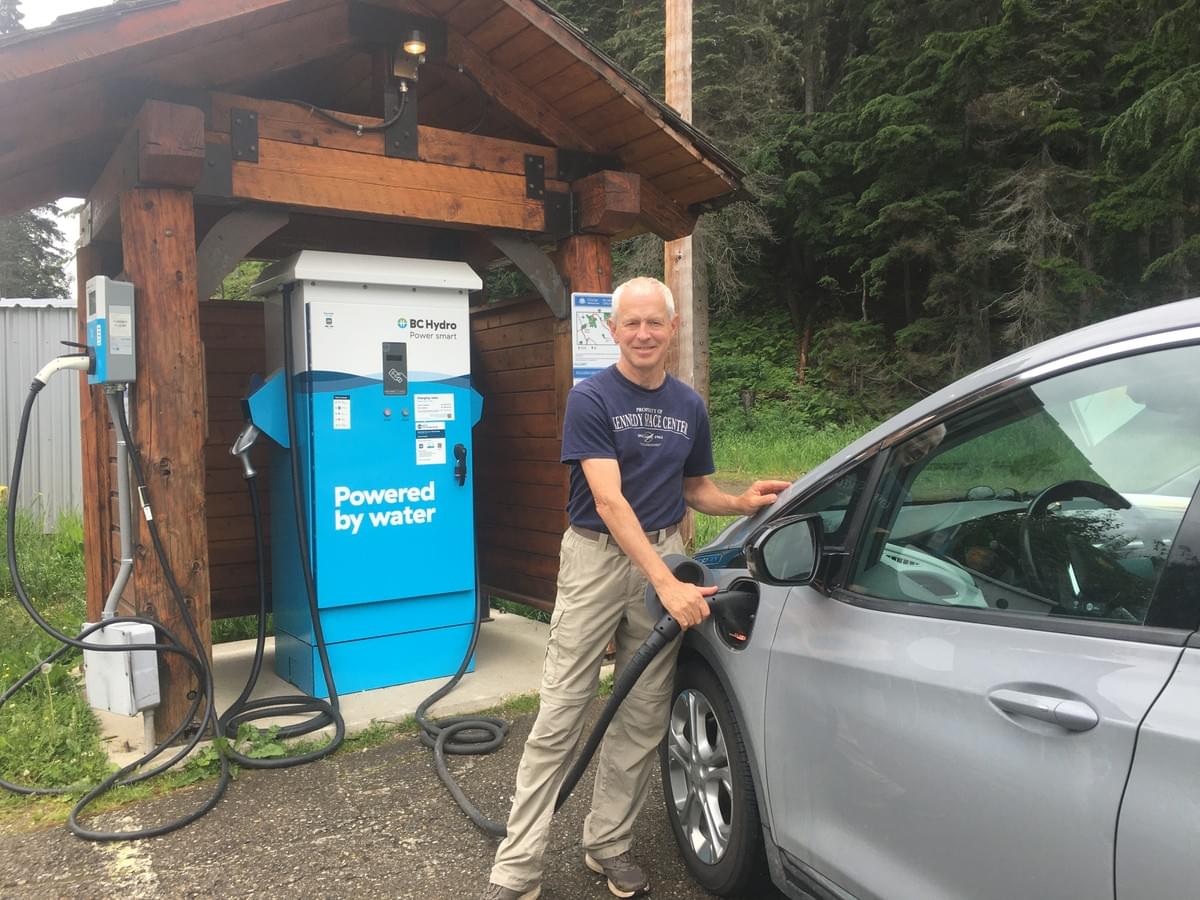We’re excited to share this guest blog by Carl Duivenvoorden, one of our dedicated Climate Reality Leaders and a valued member of our Board!
Carl brings years of experience as a speaker, writer and sustainability consultant, and a deep personal commitment to building a just, sustainable future. In this piece, he takes us along on his family’s coast-to-coast EV journey, offering practical tips and candid reflections from the road.
In this, the year of the staycation, you might wonder: is it possible to drive across Canada coast-to-coast in an electric vehicle (EV)? And is it cheaper than gas?

Carl visits several charging stations during his family's Great Canadian EV Road Trip: (from left to right) Port Alberni, BC; Cyprus River, MB; Mount Robson, BC; and White River, ON.
I’m happy to report that the answer to both questions is a resounding YES! My family and I have just gotten back from a seven-week, 16,000 km journey in our 2019 Chevrolet Bolt that took us from New Brunswick (NB) all the way to Victoria, British Columbia (BC) and back. Here are a few takeaways from our experience – including from when things didn’t quite go 100% as planned!
- The best charging networks are in Quebec and BC, with plenty of well-situated chargers in both provinces. For the most part, NB, southern Ontario and the Prairie Provinces have a good network of chargers along the main routes; an exception would be southern Saskatchewan, where coverage is a bit thin.
- The most challenging part of the route is Northern Ontario, where chargers are fewer and further apart. The worst stretch: Sault Ste. Marie to White River, 315 km without a single charger. (On our trip westward, we arrived in White River with less than 30 km range left – phew!). The iconic Icefield Parkway between Jasper and Banff National Parks takes a bit of planning too, with no fast chargers in Banff, in Lake Louise or anywhere along the 290 km route.
- It's essential to have a tool (IE app orwebsite) to locate chargers. We used Plugshare, which shows all stations of all networks on a Google map. Other options include Transport Canada, ChargeHub and A Better Route Planner. Some vehicles come with their own systems too; Tesla’s is very good.
- Most charging stations are part of networks. Popular networks in Canada include Flo (national); ChargePoint (national, but with fewer stations than Flo); eChargeNetwork (NB); Electric Circuit (Quebec); BC Hydro (BC); Ivy (Ontario); Shell ReCharge; PetroCanada and Tesla.
- In most cases, you need to join a network and set up an account to access that network’s chargers. Then you need an app or swipe card when you pull up to a charger to unlock it for use. A few networks, such as PetroCanada’s, don’trequire an account and can be accessed simply with a credit card.
- There are many partnerships among networks, so an app or swipe card for one network will work on other networks (the same as your bank card works at ATMs of other banks). For example, you can access Flo and Electric Circuit chargers with an NB eCharge Network account; you can access BC Hydro chargers with a Flo account.
- For our trip, we used four network accounts:
- NB eCharge Network: worked on Flo chargers all across Canada
- Flo: worked on Flo chargers all across Canada, plus BC Hydro chargers
- ChargePoint: worked on a smattering of chargers all across Canada
- Ivy: worked exclusively on Ivy chargers in Ontario; essential for getting through Northern Ontario
- EV range can be significantly impacted by headwinds, cool weather, rain or hilly terrain. It’s helpful to be alert to such conditions; to know how your own EV responds to them; and to plan accordingly. The few times on our trip that we ran low on range were all due to my underestimating the impact of the above conditions.
- A key to success in longer journeys is to start the day with a full battery; for our Bolt, that means about 400 km of driving before needing a charge. To achieve that, we always selected overnight accommodation with Level 2 chargers (the ones that fill a battery in 8-10 hours) onsite or within walking distance. A bonus: Level 2 chargers at parks, campgrounds and hotels are often free of charge!
- The total charging cost for our 16,000 km journey was $660, or about 4 cents per km. For comparison, doing a similar journey in a Honda Civic would have cost more than twice as much in fuel; in a Chevy Equinox SUV three times as much; and in a Ford F-150 pickup four times as much. As well, the Bolt required not a penny in maintenance, whereas gas vehicles would have required at least two oil changes.
- Doing a similar journey in a Honda Civic would have resulted in two and a half tonnes of greenhouse gas emissions; in a Chevy Equinox SUV 3.2 tonnes of emissions; and in a Ford F-150 over four tonnes of emissions.

Carl charges his 2019 Chevrolet Bolt at a BC Hydro charger at the Rogers Pass Visitors Center in British Columbia.
The verdict: driving across Canada in an EV is not only possible, it’s economical! So when your next great road trip beckons, why not go electric, for savings and zero emissions?
Interested in learning more? Hear my interview on CBC Radio’s What On Earth, aired July 20!
About Carl
Carl Duivenvoorden was raised on a dairy farm in northern New Brunswick. His diverse early agricultural career took him to over 25 countries. But from his early days growing up in Belledune, Carl always had an uneasy concern about human impacts on our global environment.
In 2006, he read “An Inconvenient Truth," the book that catapulted climate change onto the global agenda. In April 2007, he became one of the first Canadians to be personally trained by former US Vice President Al Gore to present live versions of his Academy Award-winning slideshow.
Since then, Carl has worked as a speaker, writer and sustainability consultant, helping people and organizations save money, energy and our environment. He’s presented to over 500 audiences, and his column Green Ideas ran for 10 years in New Brunswick dailies.
Carl cares deeply about our global environment. He believes climate change can be solved, but it will take all of us, working together. He looks forward to sharing thoughts on where we are, where we need to go and how we’ll get there, together.
Follow Carl's blog, Carl's Green Ideas.